 In 2009, my friend Mur Lafferty challenged me to complete NaNoWriMo in half a month. For the un-initiated, NaNoWriMo is National Novel Writing Month and it falls in November each year. To win, write at least 50,000 words of a new extended work of fiction starting at midnight on the morning of November 1 and ending at midnight in the evening of November 30. For most normal purposes, 50,000 words is a rather long novella or a rather short novel, but it’s a handy target and every year thousands of erstwhile novelists from around the globe pit themselves against their keyboards and the clock.
In 2009, my friend Mur Lafferty challenged me to complete NaNoWriMo in half a month. For the un-initiated, NaNoWriMo is National Novel Writing Month and it falls in November each year. To win, write at least 50,000 words of a new extended work of fiction starting at midnight on the morning of November 1 and ending at midnight in the evening of November 30. For most normal purposes, 50,000 words is a rather long novella or a rather short novel, but it’s a handy target and every year thousands of erstwhile novelists from around the globe pit themselves against their keyboards and the clock.
In 2007, I completed the first draft of South Coast in November and had the podcast out by Christmas. In 2008, I failed to break the 2,000 word mark because of day job conflicts–travel, new high-priority projects, etc. In 2009, I accepted Mur’s challenge and the result was the first draft of Ravenwood. The first of what I hope will be a new series of works set in a fantasy setting.
Why fantasy?
2009 was the year of The Challenge with NaNoWriMo. After I accepted the speed challenge from Mur, another friend challenged me to get out of my genre and write a fantasy work while a long time beta reader finally nailed me down to write a female lead character. Little did I know how much of a challenge it would be, or how much fun I’d have working in this new country.
Keeping with my idea of twisting tropes, I approached the Epic Quest Fantasy by first identifying the things I wanted to change. In the typical story, the kid leaves home to seek fame and fortune (or escape the boredom of the farm) and adventures across the land becoming a hero and gaining powers as they go. So, I wanted to tell the story of an older person on a quest to find a place to settle down and write her magnum opus — a book on the collected herb lore collected from a lifetime on the road. The result is Tanyth Fairport – a wandering herbalist in the autumn of her years in search of the last of the keepers of the Old Knowledge.
I had so much fun with this book, I can hardly wait to get back into the world.
 Recently a friend pointed out that if he typed in nathanlowell.com, it came to my website but then he couldn’t find my books. I realized that he did something perfectly normal that I never would have considered. The links were there but hard to find. There was a big picture of me, but a lot of little blocks of text.
Recently a friend pointed out that if he typed in nathanlowell.com, it came to my website but then he couldn’t find my books. I realized that he did something perfectly normal that I never would have considered. The links were there but hard to find. There was a big picture of me, but a lot of little blocks of text.